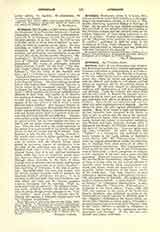

Avempace (IBN BADSHA, or IBN BADJA, called by the Scholastics AVEN-PACE and AVEMPACE), Arabian philosopher, physician, astronomer, mathematician, and poet, b. at Saragossa towards the end of the eleventh century; d. at Fez, 1138. In 1118 he was at Seville, where he wrote several treatises on logic. Later, he went to Granada and to Africa. He was, according to Arabian accounts, poisoned by rival physicians. He wrote treatises on mathematics, medicine, and philosophy, and commented on several of Aristotle‘s works, notably on the “Physics”, “Meteorologica”, “De Generatione et Corruptione”, portions of “Historiae Animalium” and “De Partibus Animalium”. His works on philosophy included logical treatises, a work “On the Soul“, “The Hermit’s Guide” (Munk translates the title “Regime du Solitaire”), “On the Union of the Intellect with Man“, and a “Valedictory Letter” (cited in Latin as “Epistola de Discessu” and “Epistola Expeditionis”). Avempace’s logical treatises are said to exist in MSS. in the Escorial Library. His other writings are either lost or still undiscovered. Fortunately, however, a .Jewish writer of the fourteenth century, Moses of Narbonne, has left us an account of “The Hermit’s Guide”, which supplements Averroes‘ unsatisfactory allusions to that work, and enables us to describe the doctrines it contains. The aim of the treatise is to show how man (the hermit) may, by the development of his own powers of mind, attain a union with the Active Intellect. (See Arabian School of Philosophy) Avempace distinguishes two kinds of action: animal action, which is a product of the animal soul, and human action, which is a product of the human soul, that is of free will and reflection. The man who smashes a stone because it has hurt him performs an animal action; but he who smashes the stone so that it will not injure others performs a human action. Now, the first step in the moral education of the hermit is to teach himself to be ruled by will and reason, so that his actions may all be human. That, however, is only the first step. Having attained it, the hermit must strive to higher perfection, so that his actions may become divine. He must strive to come in contact with the spiritual forms, which ascend in increasing degrees of incorporeity from the ideas of the individual soul up to the Actual Intellect itself, above which are only the forms of celestial bodies, that is to say, spiritual substances which, while they have an important cosmic function, have no relation to moral excellence in man. Through ideas, therefore, to the ideas of ideas, through these to abstract ideas of things, and through these last, to the pure form of the Active Intellect—this, according to Avempace, is the way of perfection. The mind which has come into contact with the Active Intellect becomes itself an intellect, the Acquired Intellect (Intellectus Adeptus). It is in reference to this last point that the Schoolmen, notably Albert the Great and St. Thomas Aquinas, mention Avempace and his teaching. Their acquaintance with the author of “The Hermit’s Guide” was made, probably, through his disciple and admirer Averroes, though certain passages in the “Contra Gentiles” would justify the surmise that St. Thomas had perhaps a firsthand acquaintance with the “Epistola Expeditionis”.
WILLIAM TURNER

